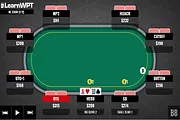Advanced Overbetting Strategy When Playing Deep-Stacked Poker

I have often said that deep-stacked no-limit poker is the purest form of the game because it allows for so much more creativity than the normal 50-big blind or 100-big blind stacks that we see these days.
There are so many more mind games that get employed once stacks are 200 BB, 300 BB or more. This is also a great time to run massive bluffs against the right type of player.
But something else that rarely gets discussed is how to use an overbetting strategy when deep-stacked. For me personally, this has long been one of my most powerful tools when playing deep-stacked poker at the lower stakes.
The following poker hand presents a perfect example of the value of overbetting when deep-stacked:
Starting from preflop, a very loose and passive recreational poker player open-raises from middle position and another player calls on the button. The loose recreational player has a little over 450 big blinds to start the hand and we cover, so this hand is going to be played insanely deep.
Now normally with a hand as strong as J♥J♠ I would really like to see a reraise here out of the small blind. The reasons why are numerous.
We can start with the strength of our hand. Pocket jacks is the fourth-best starting hand in the game. And the HUD stats tell us that this player is opening 12 percent of his hands. Pocket jacks is simply way, way ahead of this range, so a reraise is 100 percent for value.
However, even more importantly, we are out of position in this hand and the stacks are incredibly deep. I think we have so much more to gain here by juicing up the pot with a hand this strong and forcing our opponent to put more money in the middle now, while we have a large advantage.
There's another important factor to support three-betting here. As mentioned in the video above, recreational poker players tend to give more action in reraised pots.
This is something that I talk about in much more detail in my book Crushing the Microstakes. In the "Fish Psychology" section of the book, I explain how recreational players like to play sheriff and fight for pots much more when there has been a three-bet preflop.
This tendency also makes such players much more likely to make a big mistake against us. And when we are over 450 big blinds deep (effective stacks) in this hand, that is exactly what we want!
In this hand we do manage to hit middle set on the flop. Being out of position as the preflop caller, I actually prefer a check-raise in this spot. This allows us to trap a lot more dead money in the middle.
However, when you are this deep-stacked, leading here can be okay as well. The reason why is because this potentially allows us to get raised, which allows us to reraise and force a huge amount of money in the middle when we have the second-best hand possible.
The most important thing to remember when playing mega deep-stacked like this is that in order to play a really big pot you are going to have to start building it. This is absolutely not the time to slow-play. The fact of the matter is, overbetting versus recreational players allows us to win more.
The recreational player decides just to call and we see a total brick on the turn, an offsuit five. Once again you could go for a check-raise here against a more aggressive opponent. However, I really like the decision to go for the slight overbet in a spot like this versus this opponent.
Remember, we are up against a loose-passive recreational player. This type of player will have a wide range here, including any ace. Since these opponents absolutely hate to fold anything (especially top pair!), this is an excellent opportunity to exploit that weakness.
The river brings another jack, making us quads. This is obviously a good card for us but in some ways it is also a bad card. That's because this river makes it difficult for our opponent to have a really strong second-best hand. We simply have the board crushed at this point with quads.
However, as mentioned, recreational players like this simply do not like to fold anything like top pair, so I absolutely love the decision here to go for the double-pot overbet. This is the textbook way to crush calling stations like this at the lower stakes. This overbetting strategy exploits this key weakness of theirs to the max — as demonstrated by the result of this hand.
Most average poker players do not win a 500-big blind pot here. They win a much smaller one because they use "standard" bet sizes. They fail to think outside the box a bit and realize how an overbetting strategy allows us to win so much more versus a loose player like this when the stacks are extremely deep.
Let me know in the comments below how you play deep-stacked poker. Do you ever use overbetting strategies like this?
Nathan "BlackRain79" Williams is the author of the popular micro stakes strategy books Crushing the Microstakes, Modern Small Stakes, and The Microstakes Playbook. He also blogs regularly about all things related to the micros over at www.blackrain79.com.










